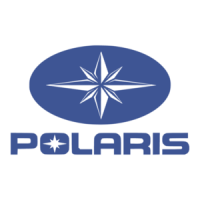
Do you have a question about the Polaris WATERCRAFT Virage TXi and is the answer not in the manual?
Lists specialized tools required for personal watercraft service and their part numbers.
Lists recommended torque specifications for stainless steel fasteners in SAE and Metric sizes.
Provides essential guidelines for performing service work safely and correctly, including best practices.
Details recommended maintenance tasks and intervals based on time and operating hours.
Outlines critical safety precautions when handling and installing batteries.
Procedure for performing a compression test to assess engine condition.
Essential safety warnings and precautions for handling gasoline.
Detailed procedure for flushing the cooling system, especially after saltwater use.
Recommended procedure for fogging the engine to prevent internal corrosion during storage.
Instructions for measuring impeller clearance and replacing parts if worn.
Detailed procedure for adjusting the steering cable for proper alignment.
Step-by-step instructions for making minor and major adjustments to the steering cable.
Guide to identifying possible causes for various engine and operational symptoms.
Troubleshooting guide for identifying and resolving lean fuel conditions.
Troubleshooting guide for diagnosing causes of poor engine performance.
Troubleshooting guide for identifying and resolving rich fuel mixture conditions.
Troubleshooting common engine issues like overheating and hard starting.
Troubleshooting guide for electrical system issues, including no spark or weak spark.
Troubleshooting common causes of vibration and pump issues.
Procedure for diagnosing and repairing engines that have been hydrolocked by water or fuel.
Lists torque specifications for engine fasteners for 700cc and 1200cc engines.
Important guidelines and safety precautions for removing the engine from the watercraft.
Step-by-step instructions for disassembling the engine, including component removal.
Detailed instructions for reassembling the engine, including torque specifications and lubrication.
Procedures for inspecting engine components like starter drive, cylinder heads, and pistons.
Procedure for checking crankshaft indexing to ensure proper cylinder timing and engine balance.
Procedure for testing carburetor pop-off pressure and identifying causes of incorrect pressure.
Essential safety warnings for gasoline handling and instructions for replacing the fuel filter.
Instructions for adjusting carburetor mixture screws for proper idle and throttle response.
Step-by-step guide for disassembling and inspecting Keihin carburetors.
Procedure for cleaning carburetor passages and components using appropriate cleaners.
Instructions for reassembling Keihin carburetors, emphasizing cleanliness and proper part installation.
Procedure for adjusting the engine idle speed to specifications using a tachometer.
Procedure for setting base mixture screw settings for Keihin carburetors.
Guidelines for checking fuel pump output, cleaning, and inspecting the impulse diaphragm.
Procedure for testing the accelerator pump operation for proper fuel delivery.
Procedure for testing fuel lines for air leaks that can cause lean conditions.
Troubleshooting guide for common exhaust system problems like poor performance and overheating.
Diagnostic guide for identifying and resolving pump ventilation or cavitation issues causing poor performance.
Step-by-step instructions for safely removing the pump assembly from the watercraft.
Detailed instructions for assembling and installing the pump, including torque and sealing.
Instructions for verifying and adjusting pump alignment to ensure proper driveshaft alignment.
Detailed steps for removing and installing the intake scoop and ride plate, including silicone application.
Detailed procedure for removing and installing the steering cable, including safety warnings.
Procedure for adjusting the steering cable for proper alignment and operation.
Troubleshooting flowcharts for RPM limiter issues on carbureted and DIt models.
Troubleshooting steps for the warning system, including fuel gauge and overheat warnings.
Troubleshooting guide for the LR-505 start/stop regulator module.
Troubleshooting guide for the LR-503-1 start/stop regulator module.
Detailed procedures for testing battery condition using OCV, specific gravity, and load tests.
Instructions for dynamically adjusting ignition timing using a timing light and dial indicator.
Using the Ignition Point Adjustment Unit to set ignition timing accurately.
Troubleshooting guide for PVL ignition systems, focusing on RFI and spark plug issues.
Specific troubleshooting steps for PVL ignition on 700cc carbureted engines.
Specific troubleshooting steps for PVL ignition on 1200cc carbureted engines.
Step-by-step instructions for disassembling the starter motor.
Procedures for inspecting starter motor brushes, armature, and housing.
Instructions for reassembling the starter motor, including parts list and lubrication.
Troubleshooting guide for starter motor issues like failure to turn or slow operation.
Explanation of the S.L.O.W. system and the conditions that trigger it.
List of service codes related to S.L.O.W. activation and their meanings.
Tests for fuel system pressure, injector resistance, ignition coils, sensors, and TPS.
List of service codes, their descriptions, and classes (Hard, Intermittent, Repaired).
Troubleshooting guide for common Ficht Fuel Injection System symptoms and corrective actions.
Overview of static tests for fuel injectors, ignition firing, and fuel pump.
Procedure for testing individual fuel injectors using the diagnostic software.
Procedure for testing the ignition system using a spark checker or timing light.
Procedure for testing the electric fuel pump operation using the diagnostic software.
Procedure for performing a cylinder drop test to diagnose misfires or performance issues.
Procedure for verifying engine timing using the FFI Diagnostics software.
Displays detailed information about specific service codes, including class, events, and hours.